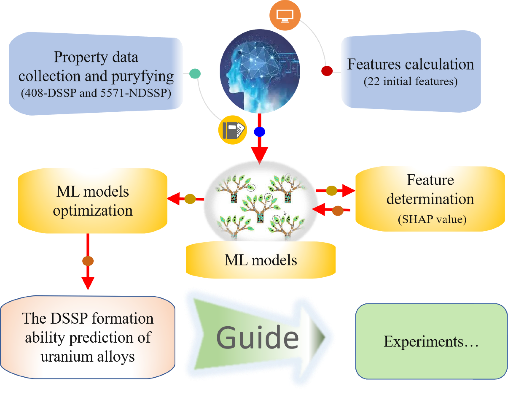The design and properties of uranium-based high entropy alloys
He Huang1, Xin Wang1, Jie Shi2, Tao Fa1*, Daqiao Meng1*
1 Institute of Materials, China Academy of Engineering Physics, Mianyang, Sichuan, 621908, China
2 Surface Physics and Chemistry of Science and Technology, Mianyang, Sichuan, 621907, China
EXTENDED ABSTRACT: Nuclear energy represented by fusion and fission energies is an effective way to solve the future energy crisis of mankind. Due to its extreme operating conditions, higher performances of structural and functional materials are required for its safe and reliable operation. Focusing on the improvement of service performances of specific fusion/fission materials, the phase structure prediction and strength-toughness design of new nuclear energy high-entropy alloys are carried out based on high-throughput theoretical calculations. In this work, we built a machine learning (ML) model of disordered solid solution alloys (DSSAs) based on about 6000 known multi-component alloys and several materials descriptors to efficiently predict the DSSAs formation ability. To fully optimize the ML model, we developed a multi-algorithm cross-verification approach in combination with the SHapley Additive exPlanations value (SHAP value). We found that the ΔSc, Λ,Фs,γ and 1/Ω, corresponding to the former two Hume-Rothery (H-R) rules, were the most important materials descriptors affecting DSSAs formation ability. When the ML model was applied to the 375 uranium-bearing DSSAs, 190 of them were predicted to be the DSSAs never known before. 20 of these alloys were randomly synthesized and characterized. Our predictions are in-line with experiments with 3 inconsistent cases, suggesting that our strategy offers a fast and accurate way to predict novel multi-component alloys with high DSSAs formation ability. Further, the inherent twinnability for bcc metals was analyzed based on the direct competition between twinning partial dislocation nucleation and trailing partial dislocation nucleation. Using this model, we designed several U-based high entropy alloys (UHEAs) and confirmed the presence of twins. We propose that the strategy of improvement of strength and ductility of U-based DSSAs is single phase equiaxied grain, followed by the dual-bcc phase with an alternative of hard and soft phase. These findings shed considerable light on the data-driven design of U-based DSSAs with high performance.

Figure 1. Development of novel U-based high entropy alloys based on material informatics.

Huang He, a senior engineer. He gets his PhD guided by academician Meng Daqiao at China Academy of Engineering Physics with the major of the Nuclear Fuel Cycle and Materials. From 2016 to 2017, he worked as a post-doctor at the Royal Institute of Technology in Sweden, with his co-supervisor Levente Vitos. His research currently focuses on the design of fusion/fission structural and functional materials, serves as the chief of the ITER talent project of the Ministry of Science and Technology, and presides one innovation fund of the Chinese Academy of Engineering Physics. He also served as a reviewer for the international journals, such as Material Design, Journal of Alloys and Compounds, Applied Energy and published more than 20 papers on the international journals, such as Acta Materialia, Nature Communications, Journal of Physics: Condensed Matter, Journal of Nuclear materials.